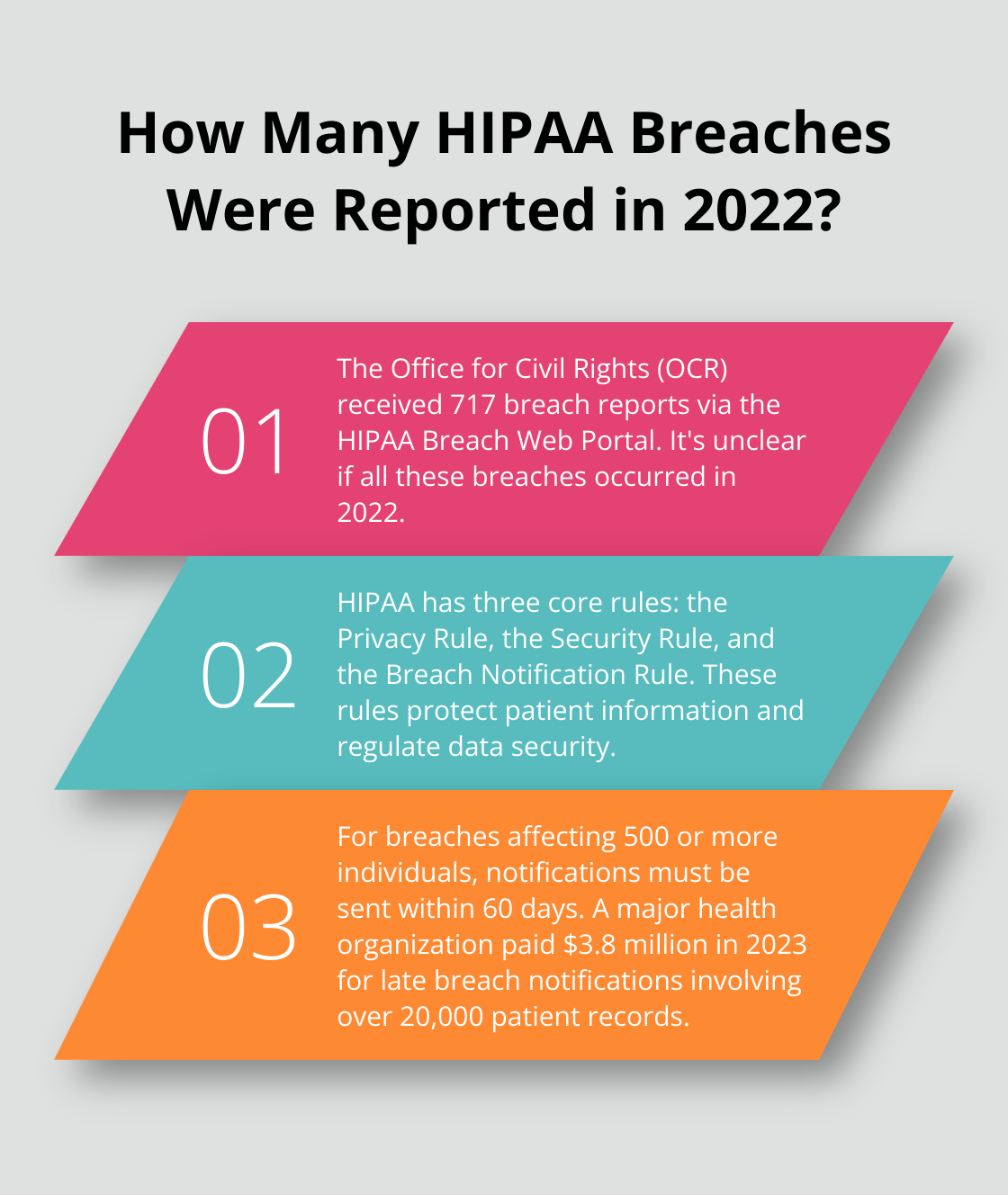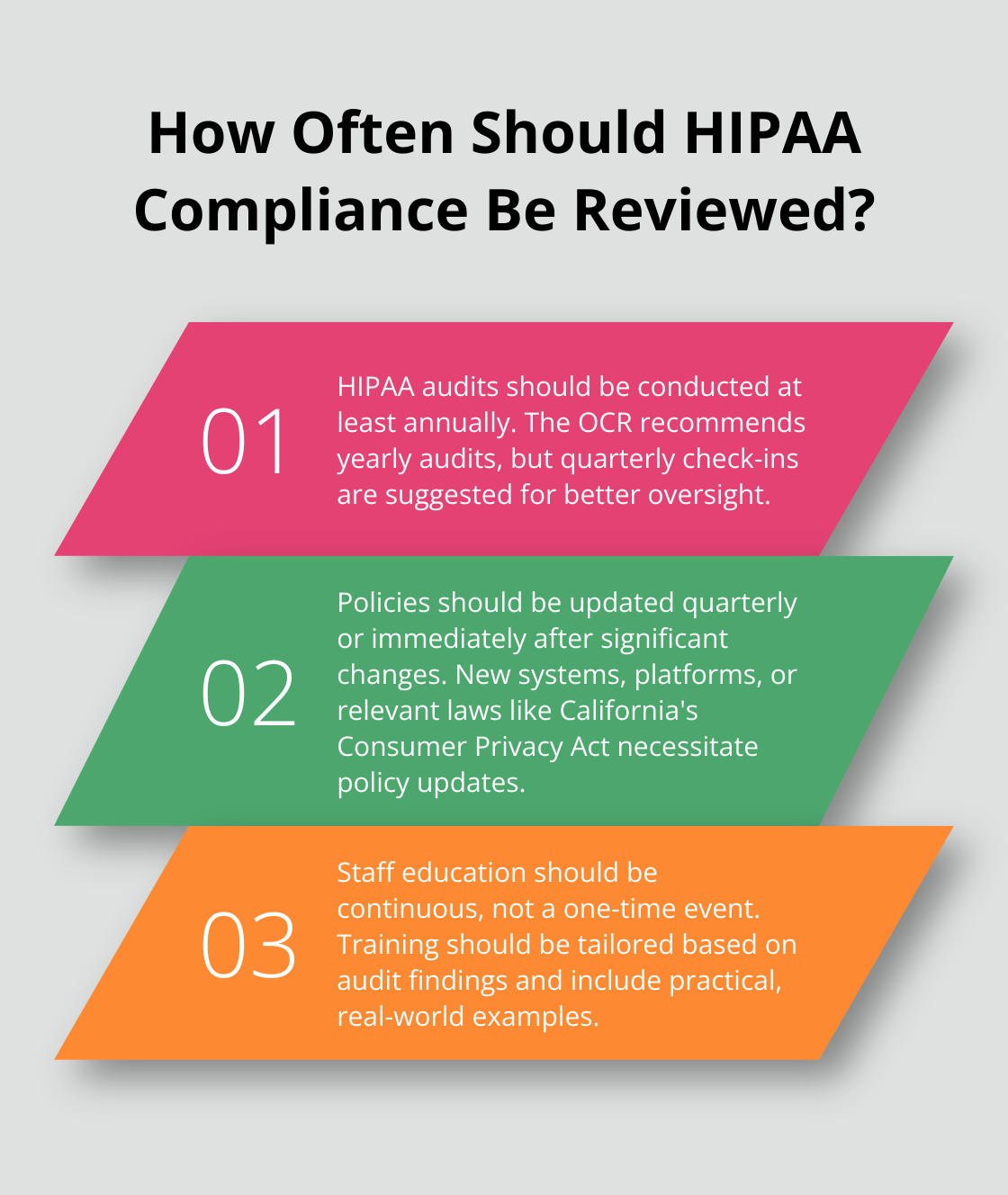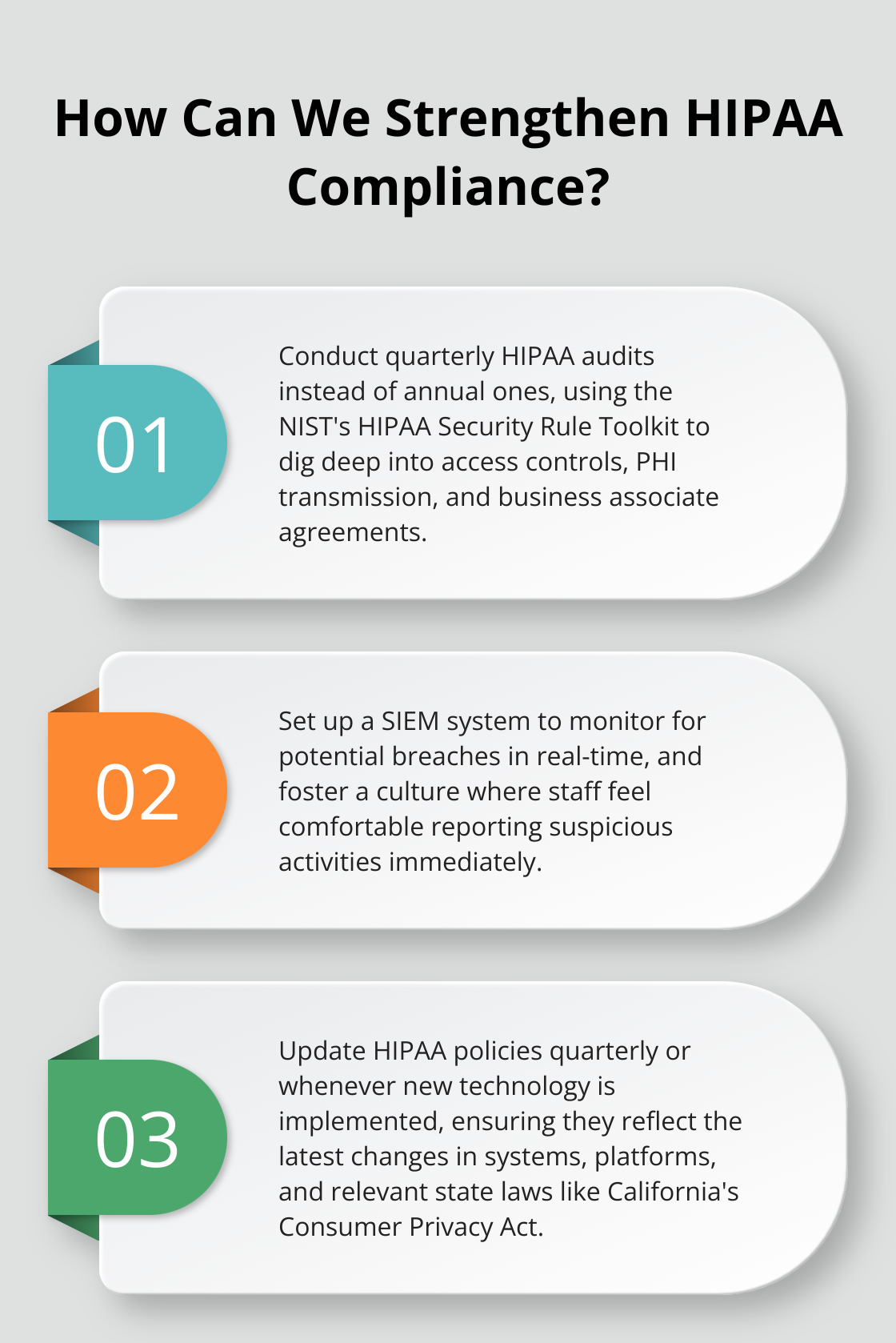HIPAA compliance — that’s the fortress around your healthcare data. Over at ScriberJoy, yeah, we get it… the regulations are a tangled web that’ll leave you scratching your head. No stroll in the park, for sure.
So, what’s the secret sauce for cracking this HIPAA nut? It’s about grasping the playbook, putting robust defenses in place, and staying sharp 24/7. Our guide right here… it’s gonna walk you through the no-nonsense steps to not just hit compliance, but stick the landing long-term. Because, let’s face it, protecting patient data and sidestepping those eye-watering fines isn’t just smart — it’s essential.
What Are the Core HIPAA Rules?
HIPAA’s like a Rubik’s Cube of regulations – all geared towards keeping patient data snug and secure. It’s built on three steadied pillars: the Privacy Rule, the Security Rule, and the Breach Notification Rule.
The Privacy Rule: Safeguarding Patient Information
So, Privacy Rule… what’s the deal? It’s the gatekeeper of Protected Health Information (PHI) – that’s your health talk, treatments, and payment tidbits wrapped up in one neat package. It draws the line on who gets a peek at your health records. Think of it like your medical bouncer. Hospitals can’t just fling your medical deets around without a nod from you (unless, you know, it’s for handling your care or wrestling with insurance).

And then there’s the minimum necessary standard – only spill the beans that matter. If a doc wants just your allergy list, no need to dump your entire medical saga on them. Easy peasy.
The Security Rule: Locking Down Electronic Data
Next stop – Security Rule. While Privacy’s got its arms around all PHI, Security’s the digital bodyguard for electronic PHI (ePHI). We’re talking digital fortresses here, strong enough to protect the integrity, availability, and privacy of ePHI at every corner – from creation to transmission.
Security Rule’s got a toolbox:
- Administrative safeguards: Blueprint for playing by HIPAA rules.
- Physical safeguards: Batten down the hatches on physical access.
- Technical safeguards: Lock up tech with encryption, access gates, and audits.
A recent report from the Office for Civil Rights (OCR) clocked in 717 breach reports via the HIPAA Breach Web Portal – whether they all happened in 2022 or not is another story.
The Breach Notification Rule: When Things Go Wrong
Even with the fortress, stuff’s gonna happen. That’s why the Breach Notification Rule is on deck – spelling out the do’s when PHI takes a hit.
If a breach rattles 500 or more souls, here’s the to-do:
- Ring up impacted folks within 60 days of finding out.
- Drop a line to the Secretary of HHS.
- Ping major media telling ’em what’s up.
Smaller breaches (sub-500 folks) still need a heads-up to affected parties and HHS, but the clock’s not quite as ominous.
Slip-ups are costly. In 2023, a big player in health forking over $3.8 million for tardy breach notifications (over 20,000 patient records were up for grabs).
Getting cozy with these HIPAA mastheads is just step one in your compliance journey. Next up – put those rules into play like a pro to keep your outfit on the right side of the tracks. Let’s unravel the how-to of applying these rules and keepin’ compliance ticking over smoothly.
How to Put HIPAA Compliance into Action
HIPAA compliance isn’t just about ticking boxes-it’s about building a fortress around patient data that’s tougher than Fort Knox. So, roll up your sleeves, let’s dive into the nitty-gritty of making HIPAA actually work in practice.
Risk Assessment: Your HIPAA Compass
Begin with a thorough risk assessment-and this isn’t a one-and-done deal. Nope, this is a never-ending story. The Office for Civil Rights (OCR) likes to see these annually, but honestly, you should always stay on the lookout.

What’s this mean in practice? Well, you gotta dig into every nook and cranny where Protected Health Information (PHI) hangs out in your organization. We’re talking all your systems-from the latest Electronic Health Record (EHR) to that dusty old fax machine. Don’t forget those mobile devices and remote setups-they’re often the weakest links in your armor.
Policies and Procedures: Your HIPAA Playbook
Once you identify the gaps, it’s time to plug ‘em. This is where solid policies and procedures come into play. These aren’t just dusty documents on a shelf. They’re your playbook for keeping PHI safe.
Your policies need to cover everything-how staff sneak peeks at patient records to what goes down when someone misplaces a work phone. Here’s the kicker: they need to be living documents. The healthcare world is a rollercoaster, and your policies should ride those twists and turns too.
Training: Your First Line of Defense
You can have the slickest policies in the universe, but they’re worthless if your team doesn’t know them inside out. Training isn’t just a checkbox on your to-do list; it’s your first line of defense against breaches.
Keep it lively. Use real-world scenarios. Don’t just do it once a year. The smart organizations weave HIPAA awareness into their daily grind. Some even toss in pop quizzes or faux phishing attacks to keep the team sharp.
Tech Safeguards: Your Digital Armor
Let’s chat about tech. This is where the rubber really meets the road in shielding electronic PHI (ePHI). Encryption, access controls, audit logs-you want the whole shebang.
Here’s a pro tip: Don’t just lob technology willy-nilly at the problem. Each tool needs to fit into your broader strategy. For example, multi-factor authentication is fantastic, but if it’s so clunky that the staff start going rogue with workarounds, well, congrats-you just made a new vulnerability.
And don’t skimp on data backups (HIPAA Security Rule demands a solid backup plan). It’s not just about having backups; it’s about restoring them in the blink of an eye when things hit the fan. Test your recovery often-you really don’t want to discover it doesn’t work when you’re knee-deep in a ransomware mess.
Implementing HIPAA compliance? It’s all about being methodical and thorough. Stay one step ahead. With these principles in mind, you’re on your way to building a HIPAA-compliant fortress. But hold on-a HIPAA journey never ends. Next, we’ll dive into how to sustain this compliance over time, ‘cause HIPAA isn’t a finish line-it’s a wild ride.
How to Maintain HIPAA Compliance Long-Term
HIPAA compliance – it’s a beast. It’s not a one-and-done kinda thing. Nah. It’s an ongoing dance. You’ve got to keep your eye on the ball. Here’s how to keep your HIPAA compliance humming along nicely.
Conduct Regular Audits
Think of HIPAA audits like a regular check-up. The OCR says do them once a year, but let’s be real – more is better. How about quarterly check-ins? You get to spot the little issues before they become big headaches.

When you’re auditing, take your time. Dig deep. Make sure your access controls are Fort Knox strong. Is PHI transmission still locked down? Business associate agreements up-to-date? Don’t just fill out the checklist – dive in. Pen tests, anyone? The NIST’s HIPAA Security Rule Toolkit is your guide here (super handy).
Update Policies Regularly
Technology ain’t slowing down, so your HIPAA policies can’t either. Best bet? Set a quarterly calendar alert to review those policies. Or don’t wait if something big goes down.
Got a shiny new EHR system? Update those policies right away. Launching a new telemedicine platform? Yep, time for a policy refresh. And here’s the kicker – state laws might throw in a curveball now and then. Take California’s Consumer Privacy Act – it’s a biggie.
Provide Continuous Education
Once-in-a-lifetime HIPAA training? Nah, not enough. Keep your crew educated. Keep it fresh. Online modules, in-person sessions, sprinkle in some real-world examples.
Here’s a pro move: Let your audit findings shape your training. If folks are goofing up and emailing PHI by mistake, slam the breaks and focus that next session on email security. Make it practical, make it memorable, and most importantly, make it stick.
Monitor for Potential Breaches
Big yikes – 2024 saw 13 data breaches over a million records. Don’t let that be you. Set up solid monitoring to catch breaches in the act.
Opt-in for a SIEM system. It’s your watchtower, spotting odd activity as it happens. But remember – tech alone doesn’t cut it. Build a culture where staff feel okay raising flags. Caught early, problems are way easier to snuff out.
HIPAA isn’t just about dodging fines. It’s about earning and keeping patient trust. Keep your HIPAA game proactive and alive. Not just box-checking – you’re protecting your patients and safeguarding your org’s good name. Stay on your toes, stay sharp, and stay compliant.
Final Thoughts
So, you want to tackle HIPAA compliance? Strap in – it’s a never-ending ride of vigilance and adaptation. The secret sauce here? It’s about mastering the fundamental rules, conjuring up solid policies, and creating a data protection culture. Think regular audits, frequent policy refreshes, and schooling the staff – that’s your compliance backbone.

And let’s not kid ourselves… keeping up with HIPAA isn’t just about dodging fines. You’re building patient trust, smoothing out ops, and claiming your stake as a data security bigwig. In this wild era of data breaches left and right, nailing HIPAA compliance? That’s your ticket to a competitive edge.
We get it at ScriberJoy – juggling compliance with patient care is like performing acrobatics. That’s why our medical transcription software is your backstage pass to compliance support and bang-on documentation (over 99% accuracy). More time for the headliner – your patients.

Leave a Reply
You must be logged in to post a comment.